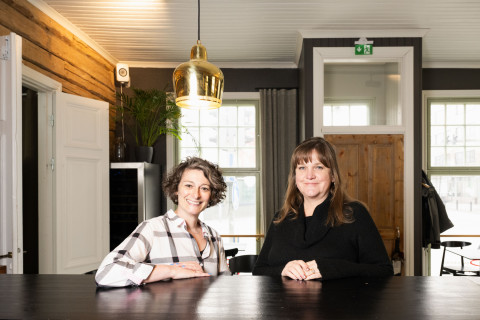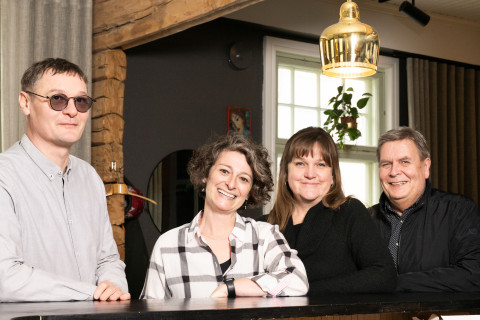The University of Eastern Finland offers its students and staff members numerous opportunities for international mobility.
“For me, becoming a Fulbright grantee was one of the best decisions I’ve ever made, but we also encourage hosting other grantees, as both roles are eye-opening,” says Senior University Lecturer Kari Sormunen, summarising his thoughts on the Fulbright Program.
Some years ago, both Sormunen and his colleague, University Lecturer Lasse Eronen, of the School of Educational Science and Teacher Education, were awarded a Fulbright grant to the United States. The Fulbright Finland Foundation offers grants for Finnish citizens to go to the US, and for US citizens to come to Finland. The foundation’s programmes support academically high-achieving students, researchers and professionals from various fields. Fulbright grants are highly esteemed and sought after both in Finland and in the United States. Collaborating with Fulbright, the University of Eastern Finland offers its students and staff a broad range of opportunities for international mobility.
“There are several different programmes to choose from. Grants can be applied for longer and shorter stays alike,” Eronen says.
Both he and Sormunen were in the United States on an ASLA-Fulbright Mid-Career Professional Development Grant, which they jokingly refer to as the “midlife crisis grant”.
“The purpose of the grant is to gain new insight into one’ professional competence. Grantees are expected to carry out a development project in their respective fields in the US, and consequently bring back new know-how and skills to Finland as well.”
The idea of the project is to take a slightly different perspective to one’s own field. Sormunen’s field pertains to the pedagogy of science education, and, during the project, he explored how diversity is observed in science education in the US.
“Spending time with people from outside your own discipline will broaden your understanding of it in a completely new way. Thanks to the time I spent in the United States, my intercultural competence and language skills grew, and I gained new perspectives on my field,” Sormunen says, summing up his experience.
Although the project wasn’t directly linked to his own field of research, he has subsequently understood that it nevertheless was beneficial, albeit indirectly.
Upon embarking on his journey to the United States, Eronen, a pedagogist of mathematics, was interested in the community culture of US schools.
“My project explored how a sense of community is manifested in education, and how teachers’ professional skills are supported with regard to community building.”
Thanks to the time I spent in the United States, my intercultural competence and language skills grew, and I gained new perspectives on my field.
Kari Sormunen
Senior University Lecturer
The Fulbright network offers support and care
“Having a Fulbright status is valuable, and for the grantee, it opens many doors in the United States. The purpose of the grant is not only to work in another country, but also to build intercultural understanding and create a Fulbright network. All of this, in my opinion, is exemplarily supported,” Sormunen says.
According to Eronen, the process associated with the Fulbright exchange is carefully thought through from the perspective of both the grantee and the host.
“After our own grant period, we were asked to host two American teachers here in Joensuu, thanks to us now being part of ‘the Fulbright family’. So, throughout this spring, we have been serving as academic mentors for these two grantees,” Eronen says.
Sormunen says that this has also provided them with an opportunity to peek “behind the Fulbright scenes”.
“For instance, we have been involved in Fulbright’s very comprehensive selection processes. It becomes clear to the applicant already during the application phase that no one is left alone during the grant period; instead, the Fulbright network is extensive, active and caring. And, of course, the same dedication and commitment are expected from the grantees as well. Everyone is part of an important network.”
An opportunity held in high regard
“We were ecstatic to find out that we had been selected as Fulbright grantees to Joensuu,” says Ms Teresa Butler-Doran, a teacher from California, US.
“I was waiting for my dentist’s appointment when I got the text about being selected, and I literally jumped out of my seat in the waiting room.”
That speaks volumes about how sought-after and respected Fulbright grants in the United States are. The grantees are described as future change-makers who contribute to the advancement of science, art or their respective professional fields. The grant programmes support candidates whose work has the potential to have far-reaching impact.
In addition to Butler-Doran, Ms Dawn A. Oler, a teacher from Illinois, US, is spending her Fulbright grant period in Joensuu. They are both enthusiastic about their ongoing projects, and what it has been like to implement them as American teachers in a Finnish school setting.
“A PhD in the United States was financially out of the question for me, so this grant felt like an especially good opportunity for professional development, and for expanding my worldview,” Oler states.

Finnish schools could have a better sense of community
Oler’s project deals with the teaching profession and the recruitment and training in the field. For the project, she wanted to find out, e.g., what kind of perceptions young people have of the teaching profession.
“When I arrived in Finland, I conducted a survey, which eventually received nearly 400 responses. Based on the results, I will explore what young people think of the teaching profession, and what might motivate them to become a teacher.”
Butler-Doran has been teaching science for over 25 years, and she hopes that her project will create a new kind of collaboration between Finnish and American schools in the field of global climate action.
“Many schools from across Finland have already joined my project, and starting next August, we will be running a joint course for a more sustainable future.”
They find that teenagers are very similar in Joensuu and back home, but some differences can be found as well.
“In Finland, there is a lot of trust in teachers, who are allowed to work independently in their classrooms. That would not be possible in the United States,” Oler notes.
They found that class sizes in Finland also seem to have fewer students. Additionally, young people in Finland appear to have a deeper respect for learning new things, compared to their peers in the United States.
So, what are the good lessons Finnish schools could learn from their American counterparts?
“A better sense of community. Here, children and teenagers leave school immediately after the last class. In the United States, schools offer various extracurricular activities that are led by teachers. Team spirit is built by school sports teams and school orchestras with their own mascots. This way, teachers also get to know students outside the classroom,” Oler notes.
“Parent-teacher collaboration is also much more active in the United States. I know the families of my students really well, which facilitates communication in all directions.”
Getting to know the culture
Besides being busy with their work and projects, the teachers have used their free time to get to know Finland and other parts of Europe as well. Together, they have visited various schools, attractions and historical sites. Moreover, countries such as Estonia, Austria, Greece and the Netherlands have become familiar this spring.
“Before coming to Finland, we were told that Finns are shy and slow to warm up to people, but we don’t think that’s true at all! People come up to talk to us spontaneously everywhere – and that’s how some of the best conversations here have started,” Oler says.
According to Sormunen and Eronen, Oler and Butler-Doran have already managed to compile an impressive list of things they’ve done and learned in Finland. For instance, words of the Finnish language learned over the spring occasionally pop up in the speech of the enthusiastic Americans.
According to Oler, Finland has proven to be a model country in many respects, and the new experiences they’ve gained have only reinforced the idea of how diverse the Fulbright Program is.
“This is such a unique opportunity, so why not make the most of it.”
According to Sormunen and Eronen, being a mentor has been very rewarding. They meet with Oler and Butler-Doran at least once a month.
“We have interesting discussions about a wide range of topics – some of them are about work, others about Finnish culture. We help them get in contact with people and suggest new places to visit,” Sormunen says.
And although the hosts are the grantees’ primary points of contact, the entire Fulbright network operates in the same way: help is always available from another member of the Fulbright family.
Before coming to Finland, we were told that Finns are shy and slow to warm up to people, but we don’t think that’s true at all!
Dawn A. Oler
Teacher
Numerous opportunities to get involved
According to Riikka Pellinen, Director for International Affairs at the University of Eastern Finland, the Fulbright Finland Foundation offers numerous opportunities for the university’s students and staff members to fund their studies, research or staff mobility to the United States.
“With the foundation’s support, it is also possible to invite American researchers to visit the University of Eastern Finland and thus build new research and teaching collaborations.”
Advantages of the Fulbright Finland Foundation’s grant programmes include a comprehensive orientation to the culture and higher education system of the destination country, advisory and support services available before and during the grant period, as well as a free visa.
“The programmes also offer a unique opportunity to build international networks and become part of the global network of Fulbright alumni.”
More information on funding opportunities available via the Fulbright Finland Foundation: https://www.fulbright.fi/ Current calls are also announced in UEF’s Research Funding Viva Engage group.
Follow Dawn Oler’s Instagram account for photos of the teachers’ stay in Finland: https://www.instagram.com/msdawnoler






